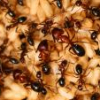hi, this 2 colonys are about 1 year old, got the queens last summer in central Missouri, thank you for any help.
1st one is about 8mm got her July of last year in a farm land setting.
2nd one is about 4 to 5mm and I got her May of last year in a paved nature trail, both in central MO
i know this 1st one is a lasius queen, but what type?
]


And my 2nd colony I believe its in the brachymyrmex family, also got in central MO. this colony does not cocoon even though they have sand inside. 

Edited by ugo, June 1 2019 - 3:58 PM.

















